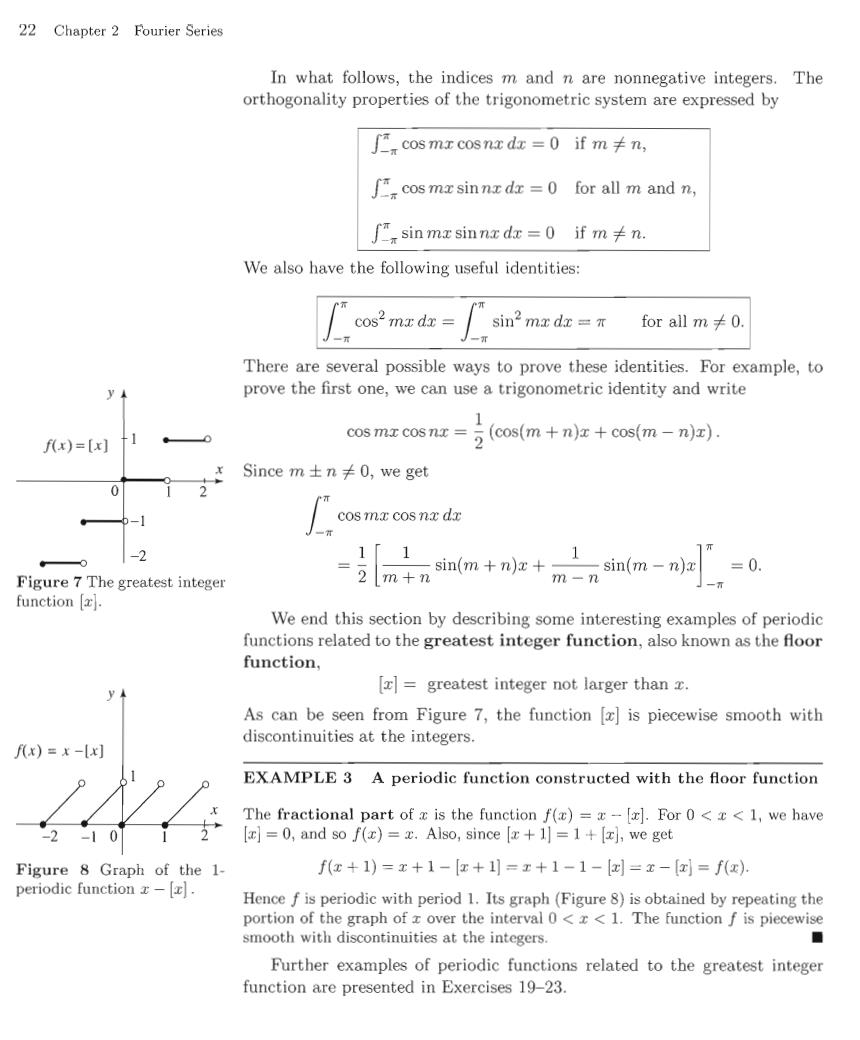
22 Chapter 2 Fourier Series In what follows,the indices m and n are nonnegative integers.The orthogonality properties of the trigonometric system are expressed by ∫cosm cosna d=0ifm≠n, ∫俨cosmxsinnz dz=0 for all m andn, ∫俨sin mz sinna da=0ifm≠n. We also have the following useful identities: cos2 mx dx= sin2mxdx=π for all m≠0. There are several possible ways to prove these identities.For example,to prove the first one,we can use a trigonometric identity and write 1 cos mx cosna f(x)=[x] 2 (cos(m+n)z+cos(m-n)). Since m土n≠0,we get cosma cosna dx -2 1 Figure 7 The greatest integer 2 -sin(m+n)+mn sin(m -n)z=0. m+ function We end this section by describing some interesting examples of periodic functions related to the greatest integer function,also known as the floor function, [x]=greatest integer not larger than z. As can be seen from Figure 7,the function [z]is piecewise smooth with discontinuities at the integers. f(x)=x-[x] EXAMPLE 3 A periodic function constructed with the floor function The fractional part of z is the function f(x)=x-[x].For 0<x<1,we have [r]=0,and so f(x)=x.Also,since [+1]=1+[),we get Figure 8 Graph of the 1- f(x+1)=x+1-x+1=x+1-1-z=x-x=f() periodic function z-[]. Hence f is periodic with period 1.Its graph(Figure 8)is obtained by repeating the portion of the graph of x over the interval 0<x<1.The function f is piecewise smooth with discontinuities at the integers. ■ Further examples of periodic functions related to the greatest integer function are presented in Exercises 19-23
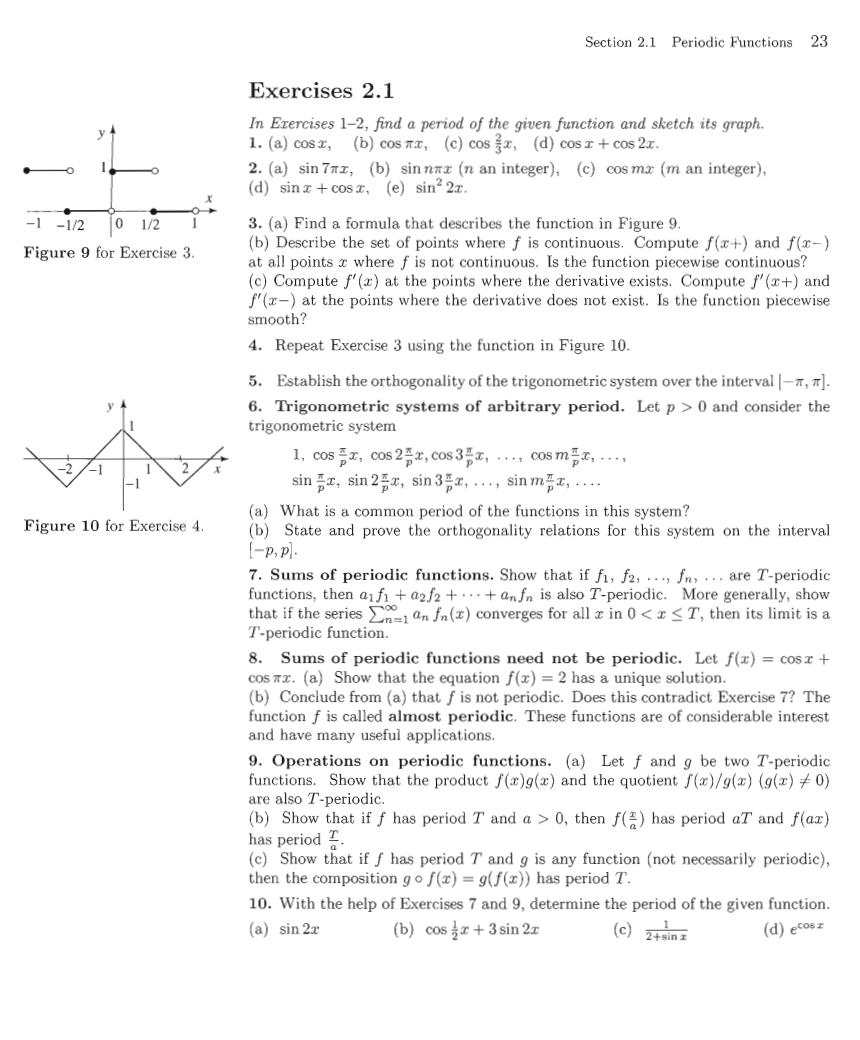
Section 2.1 Periodic Functions 23 Exercises 2.1 In Exercises 1-2,find a period of the given function and sketch its graph. 1.(a)cosz,(b)cos a,(c)cos,(d)cosz+cos2z. 2.(a)sin 7rz,(b)sinnmz (n an integer),(c)cos mz (m an integer), (d)sin x +cosx,(e)sin22x. 1-1/2 01/2 3.(a)Find a formula that describes the function in Figure 9. Figure 9 for Exercise 3. (b)Describe the set of points where f is continuous.Compute f(+)and f(x-) at all points z where f is not continuous.Is the function piecewise continuous? (c)Compute f'(z)at the points where the derivative exists.Compute f(+)and f(-)at the points where the derivative does not exist.Is the function piecewise smooth? 4.Repeat Exercise 3 using the function in Figure 10. 5.Establish the orthogonality of the trigonometric system over the interval-, 6.Trigonometric systems of arbitrary period.Let p >0 and consider the trigonometric system 1.cos cos2cos..cosm. sin马x,sin2gx,sin3gx,,sinm5x,… (a)What is a common period of the functions in this system? Figure 10 for Exercise 4. (b)State and prove the orthogonality relations for this system on the interval -p,pl. 7.Sums of periodic functions.Show that if fi,f2,...,fn,...are T-periodic functions,then aifi+a2f2+.+anfn is also T-periodic.More generally,show that if the series()converges for allinT,then its limit isa T-periodic function. 8.Sums of periodic functions need not be periodic.Let f(x)=cosz+ cos ax.(a)Show that the equation f(x)=2 has a unique solution. (b)Conclude from (a)that f is not periodic.Does this contradict Exercise 7?The function f is called almost periodic.These functions are of considerable interest and have many useful applications. 9.Operations on periodic functions.(a)Let f and g be two T-periodic functions.Show that the product f()g(z)and the quotient f()/g(z)(g()0) are also T-periodic. (b)Show that if f has period T and a>0,then f()has period aT and f(az) has period T. (c)Show that if f has period T and g is any function (not necessarily periodic), then the composition gof()=g(f(r))has period T. 10.With the help of Exercises 7 and 9,determine the period of the given function. (a)sin 2x (b)cos+3sin 2z (c)24sin (d)ecos
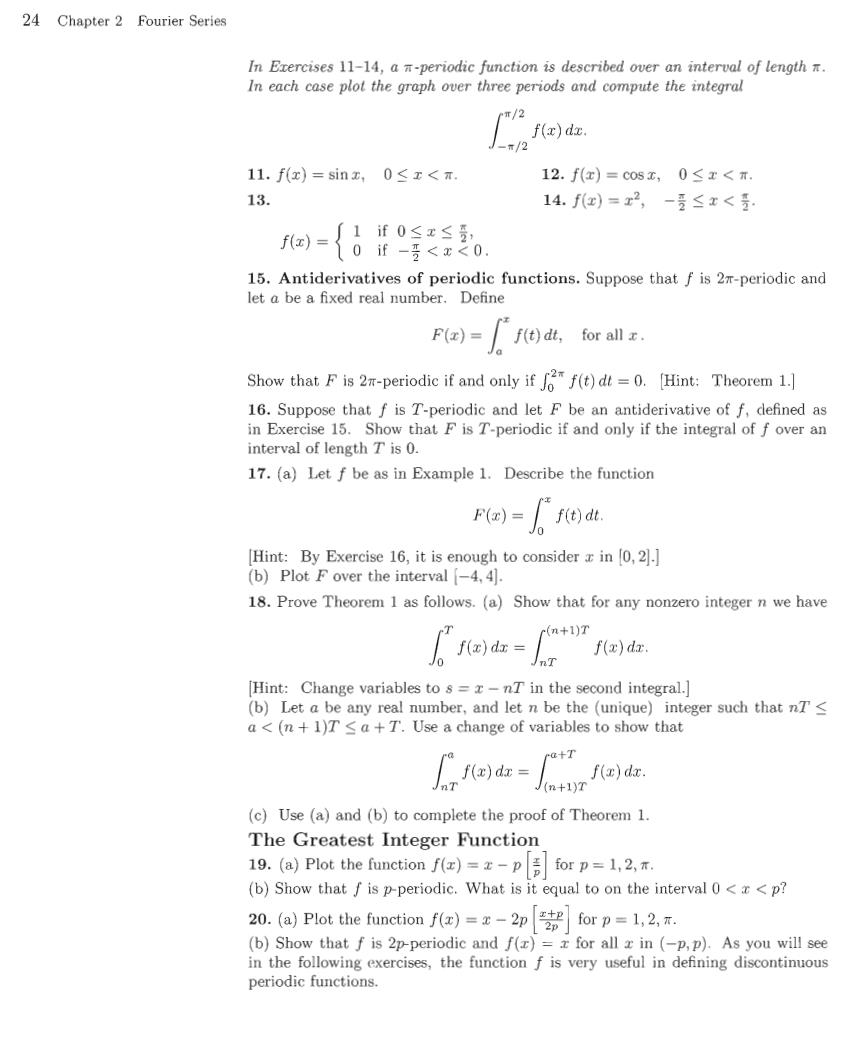
24 Chapter 2 Fourier Series In Exercises 11-14,a n-periodic function is described over an interval of length n. In each case plot the graph over three periods and compute the integral T/2 f(x)dx. T/2 11.f(x)=sinx,0≤x<T. 12.f((x)=c0sx,0≤x<T. 13. 14.fx)=x2,-号≤x<. ∫1if0≤x≤, f)={0if-号<x<0 15.Antiderivatives of periodic functions.Suppose that f is 2T-periodic and let a be a fixed real number.Define Fr)=fedt,for all. Show that F is 2r-periodic if and only iff(t)dt=0.[Hint:Theorem 1.] 16.Suppose that f is T-periodic and let F be an antiderivative of f,defined as in Exercise 15.Show that F is T-periodic if and only if the integral of f over an interval of length T is 0. 17.(a)Let f be as in Example 1.Describe the function F()=0 f(t)dt. [Hint:By Exercise 16,it is enough to consider x in [0,2].] (b)Plot F over the interval-4,4] 18.Prove Theorem 1 as follows.(a)Show that for any nonzero integer n we have (n+1)T f(x)di= f(x)da nT Hint:Change variables to s =x-nT in the second integral. (b)Let a be any real number,and let n be the (unique)integer such that nT< a<(n+1)Ts a+T.Use a change of variables to show that no- a+T f(x)da. J(n+1)T (c)Use (a)and (b)to complete the proof of Theorem 1. The Greatest Integer Function 19.(a)Plot the function f()=a-p for p =1,2, (b)Show that f is p-periodic.What is it equal to on the interval 0<x<p? 20.(a)Plot the function f()=z-2p forp=1,2. (b)Show that f is 2p-periodic and f(r)=z for all z in (-p,p).As you will see in the following exercises,the function f is very useful in defining discontinuous periodic functions
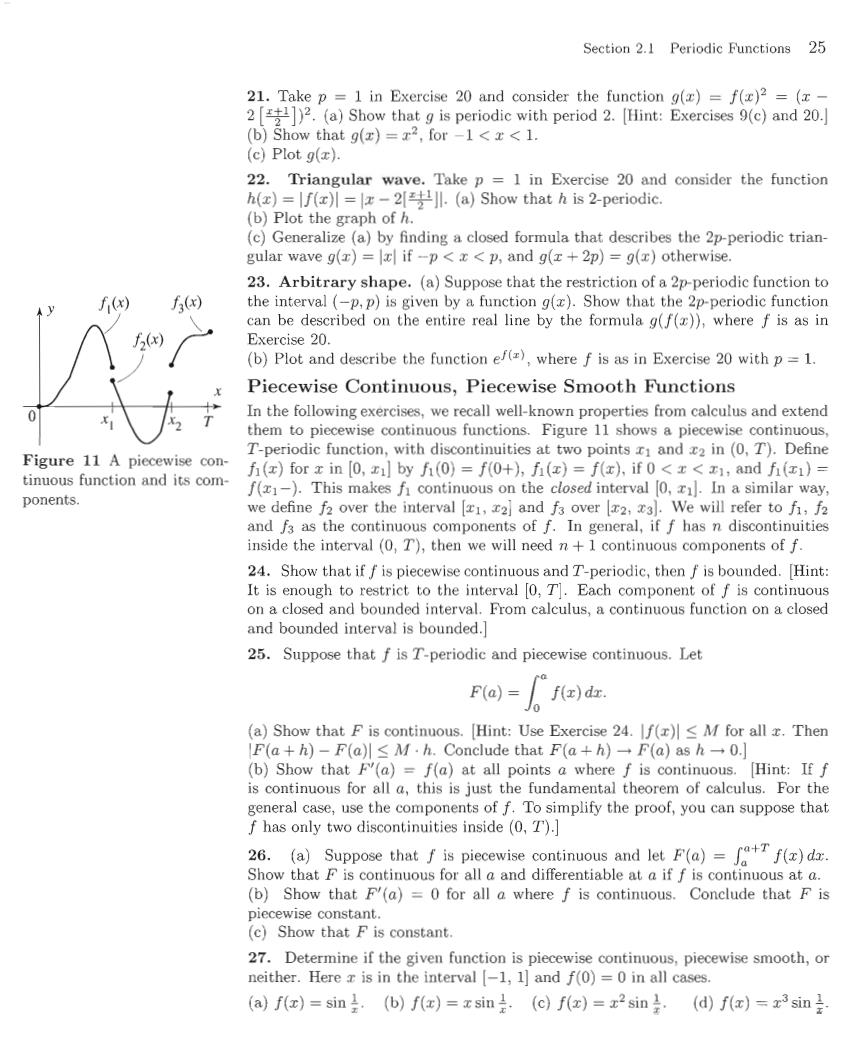
Section 2.1 Periodic Functions 25 21.Take p 1 in Exercise 20 and consider the function g(x)=f(x)2=(x- 2)2.(a)Show that g is periodic with period 2.[Hint:Exercises 9(c)and 20.] (b)Show that g(z)=22,for -1<z<1. (c)Plot g(). 22.Triangular wave.Take p 1 in Exercise 20 and consider the function h()=f()=].(a)Show that h is 2-periodic. (b)Plot the graph of h. (c)Generalize (a)by finding a closed formula that describes the 2p-periodic trian- gular wave g(r)=x if-p<x<p,and g(x+2p)=g(x)otherwise. 23.Arbitrary shape.(a)Suppose that the restriction of a 2p-periodic function to f(x) f(x) the interval (-p,p)is given by a function g(x).Show that the 2p-periodic function can be described on the entire real line by the formula g(f()),where f is as in Exercise 20. (b)Plot and describe the function ef(),where f is as in Exercise 20 with p=1. Piecewise Continuous,Piecewise Smooth Functions In the following exercises,we recall well-known properties from calculus and extend them to piecewise continuous functions.Figure 11 shows a piecewise continuous, T-periodic function,with discontinuities at two points r and z2 in (0,T).Define Figure 11 A piecewise con- fi()for x in [0,1]by f1(0)=f(0+),fi(x)=f(x),if 0<<1,and fi(1)= tinuous function and its com- f(1-).This makes f continuous on the closed interval 0,1.In a similar way, ponents. we define f2 over the interval [1,2]and f3 over [2,23].We will refer to fi,f2 and f3 as the continuous components of f.In general,if f has n discontinuities inside the interval (0,T),then we will need n+1 continuous components of f. 24.Show that if f is piecewise continuous and T-periodic,then f is bounded.Hint: It is enough to restrict to the interval [0,T.Each component of f is continuous on a closed and bounded interval.From calculus,a continuous function on a closed and bounded interval is bounded. 25.Suppose that f is T-periodic and piecewise continuous.Let F(a)=f(z)dz. (a)Show that F is continuous.Hint:Use Exercise 24.f(r)<M for all x.Then F(a+h)-F(a)I<M.h.Conclude that F(a+h)-F(a)as h-0. (b)Show that F(a)=f(a)at all points a where f is continuous.Hint:If f is continuous for all a,this is just the fundamental theorem of calculus.For the general case,use the components of f.To simplify the proof,you can suppose that f has only two discontinuities inside(0,T).] 26.(a)Suppose that f is piecewise continuous and let F(a)=f()dz Show that F is continuous for all a and differentiable at a if f is continuous at a. (b)Show that F(a)=0 for all a where f is continuous.Conclude that F is piecewise constant. (c)Show that F is constant. 27.Determine if the given function is piecewise continuous,piecewise smooth,or neither.Here x is in the interval [-1,1]and f(0)=0 in all cases. (a)fx)=sin.(b)fx)=xsin是,(c)fx)=x2sin.(d)fx)=r3sin是
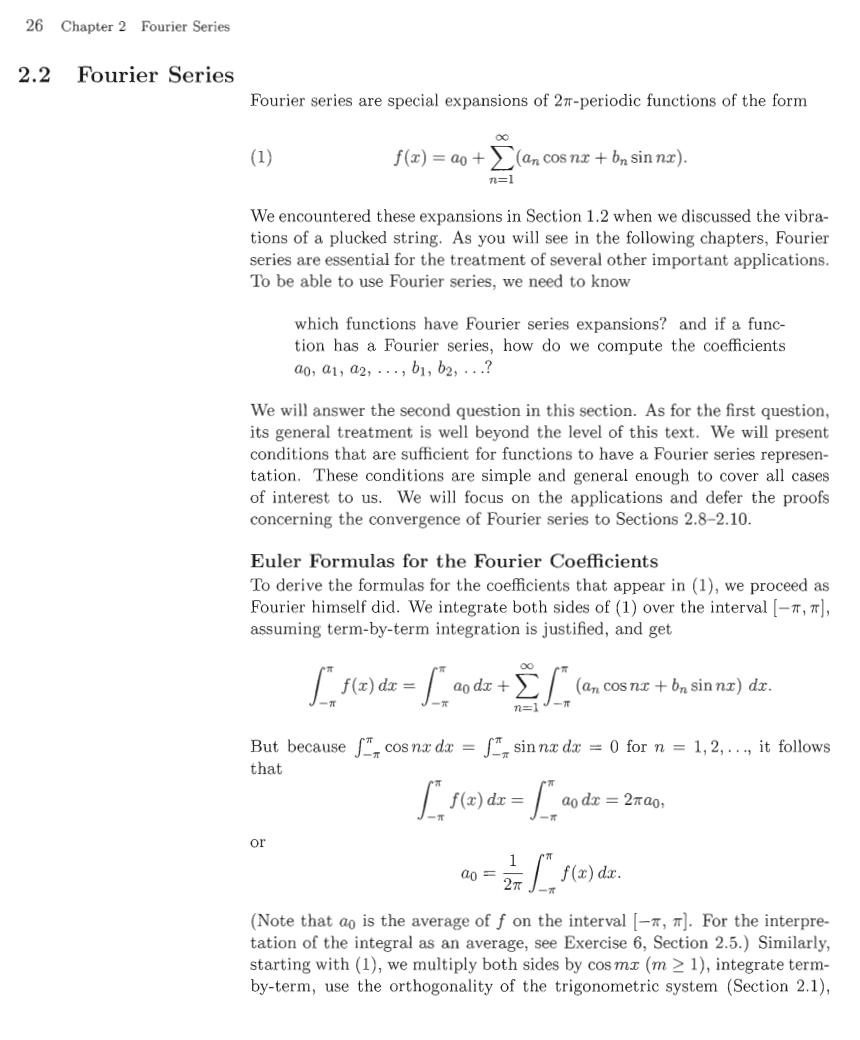
26 Chapter 2 Fourier Series 2.2 Fourier Series Fourier series are special expansions of 2m-periodic functions of the form (1) f(x)=a0+ an cos nx +bn sin nx). We encountered these expansions in Section 1.2 when we discussed the vibra- tions of a plucked string.As you will see in the following chapters,Fourier series are essential for the treatment of several other important applications. To be able to use Fourier series,we need to know which functions have Fourier series expansions?and if a func- tion has a Fourier series,how do we compute the coefficients a0,a1,a2,,b1,b2,.? We will answer the second question in this section.As for the first question, its general treatment is well beyond the level of this text.We will present conditions that are sufficient for functions to have a Fourier series represen- tation.These conditions are simple and general enough to cover all cases of interest to us.We will focus on the applications and defer the proofs concerning the convergence of Fourier series to Sections 2.8-2.10. Euler Formulas for the Fourier Coefficients To derive the formulas for the coefficients that appear in (1),we proceed as Fourier himself did.We integrate both sides of(1)over the interval [-m, assuming term-by-term integration is justified,and get L.rou-o (an cosnt+on sin nz)dx But because f"cos nx dx =f sinna dx =0 for n =1,2,...,it follows that f.rod-f ao dx 2wao, or a0= 2 f(x)dx. (Note that ao is the average of f on the interval [-]For the interpre- tation of the integral as an average,see Exercise 6,Section 2.5.)Similarly, starting with (1),we multiply both sides by cosmz (m >1),integrate term- by-term,use the orthogonality of the trigonometric system (Section 2.1)